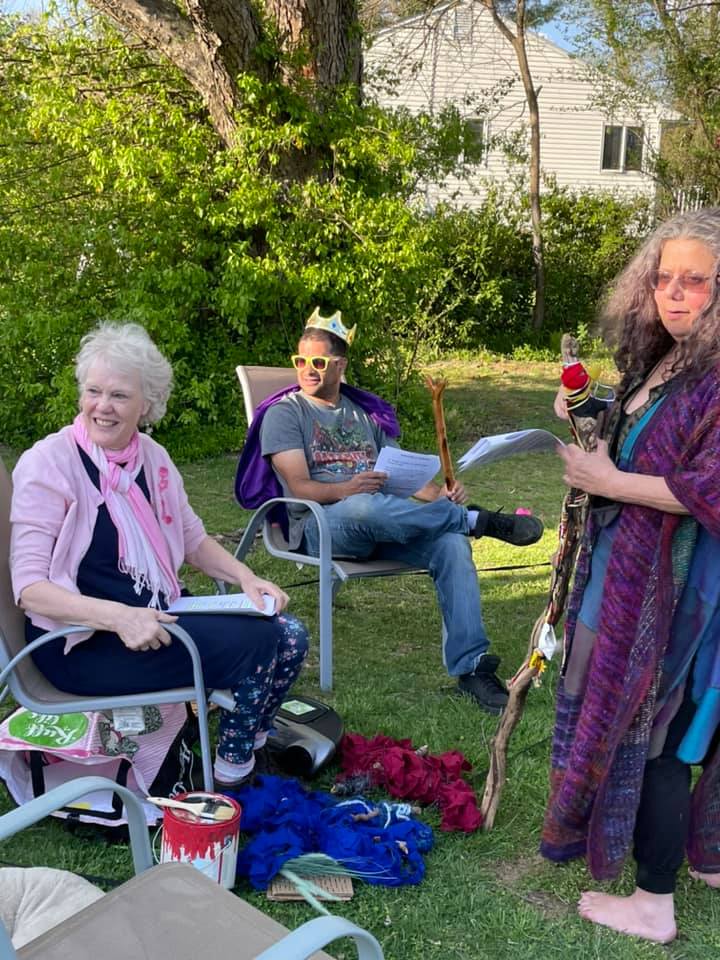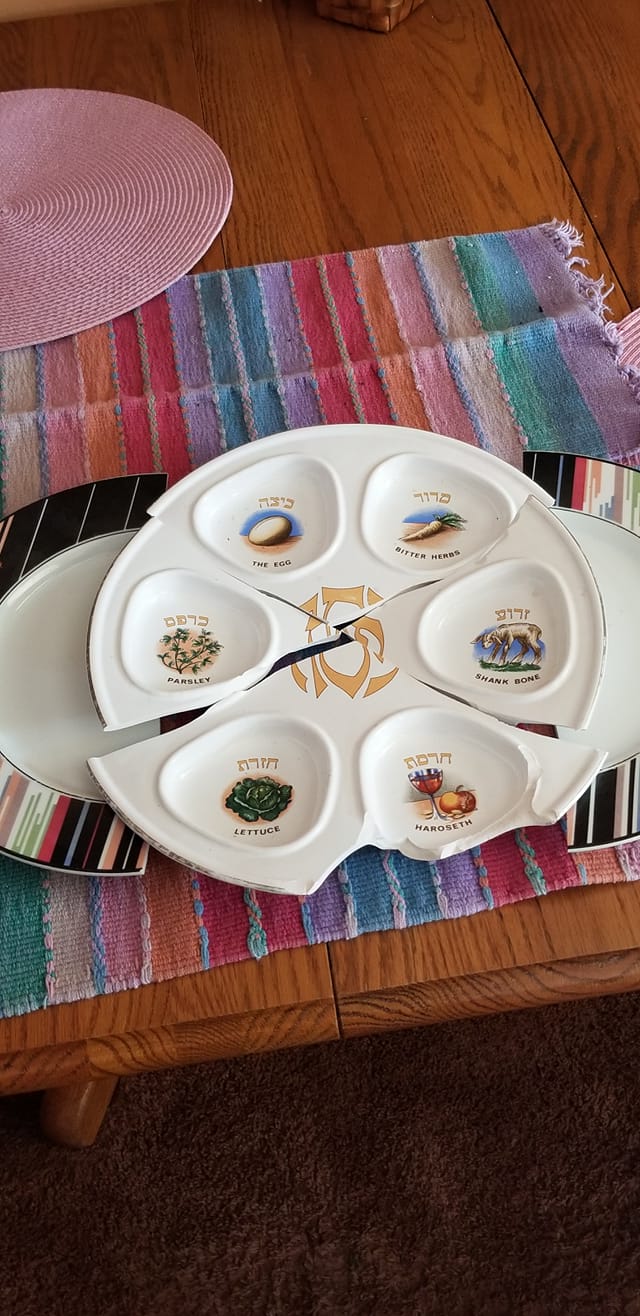Last night, I celebrated Passover with family and dear friends who are family of choice.
My son, daughter-in-law, and toddler grandson, and I crossed the river from Pennsylvania to New Jersey for an outdoor seder.
We were all vaccinated, some of us double boosted, so it seemed like a low-risk way of gathering to honor a holiday that is about freedom, redemption, love overcoming hate, taking leaps of faith, and trusting in the Divine in the face of fear and uncertainty.
It was the first time my grandson had met some of these people including a seven-to eight-year-old grandson of the hosts Fran and Rich, who took Dean under his wing. The kids were also engaged in an Easter ritual of finding colorful eggs that had been hidden for them to discover. Ace noticed that he found more of the plastic orbs that, instead of being filled with candy, contained other treasures, including little dinosaurs and whistles, so he gave some of them to Dean.
Dean took his own sense of freedom literally as he ran around their expansive yard, but it still wasn’t enough. The little one took off down the sidewalk, short little legs propelling him, heading for a neighbor’s house, at a breakneck speed. I took off after him, calling for him to stop. He just laughed and ran until I eventually caught up with him.
Keep in mind that he is two and I am 63 with COPD and a cardiac condition. Later, my son told me that everyone at the table was laughing at me hurtling after my grandson. I told him that I didn’t care how silly I looked and his safety mattered more than my image. Grandma (in my case, Bubbe—Yiddish for grandmother) love overcomes limitations.
Another friend, Janet, who is a performance artist, created a skit about the Passover story. For those who are not familiar, think about the movie “The Ten Commandments.” I was tapped to play Moses, complete with colorful robe and beautifully decorated staff. Adam’s BFF Elizar was the Pharaoh, Janet was the Narrator, Rich was the Taskmaster, and Fran was God. Food was plentiful and included matzah ball soup, kugel, broiled salmon, broccoli, salad, matzah, sparkling cider, and mashed potatoes. Love was the most important ingredient in everything on the table.

After dinner, I packed the car up in preparation for our leave taking, to make it easier to get a squirming toddler into his car seat when he would much rather stay and play some more. One of the items was the seder plate that I had inherited from my parents. I had it stashed in the back of Adam’s and Lauren’s car on the way home, and I thought it was placed securely. Apparently not, since when I opened the hatch, it fell out and crashed onto their driveway. Adam and I cleaned it up, and I called my sister to let her know. She thought it was a message from our parents. Whenever something would break in our house, mom would say, “Save the pieces and as long as nobody got hurt, it’s okay.” She knew that things could be replaced. People are irreplaceable.
This morning, I was making matzah brei (fried matzah)—for those who have never had it, it is like French toast, with matzah instead of bread. I had the plate on the counter and opened the cabinet and out fell a spice jar and smashed another plate from a set, in half. These were my parents’ dishes too. WTF? What is the message? I can’t recall the last time I broke a plate.
After that happened, I felt compelled to listen to my mother’s advice and retrieve the pieces of the seder plate, as a friend who creates beautiful mosaic art suggested that she and I work on giving the shards new life. I told my son that I wanted to come over and dig the plate out of their trash can. He made some kind of sarcastic comment that I was welcome to dumpster dive.
By the time I was heading over with a shovel and heavy gardening gloves in hand, he had already fished the fragments out and placed them on top of the bin.
As someone who believes in symbolism and messages, I had to research the meaning of broken plates. Auspicious portents and all. They had to do with breaking with the past and creating new beginnings. The Japanese concept of Kintsugi arose, which takes broken pieces of pottery, glues them together, and highlights the broken places with gold. Perfection in imperfection.
When I contemplate what the experience means to me, I have come to recognize that there are times when I feel broken, chipped away at by life. I present as “put together,” and unless people know me well, they have no clue what it takes to stay sane and vertical in a world gone bonkers. Part of my work as a therapist is to help other people maintain their footing in the midst of their own broken pieces. I help them rearrange the pieces as they wish them to be.
Psychologist James Hillman said, “You know, people come to therapy really for blessing. Not so much to fix what’s broken, but to get what’s broken blessed.”
It also means that things are just that…things, objects, representations of the love behind them. My parents’ imprints are still with me. That’s not going anywhere. The people who recently fled their home in Ukraine and for eons before in other parts of the planet have moments to take what matters most to them and leave the rest behind in service to their survival.
Many who are grieving now may feel broken. I’ve heard that when a bone breaks and then heals, the place where the fracture occurs becomes stronger. I believe it’s true with human hearts as well.
One of my favorite songs is called “In The Broken Places” by David Wilcox. A line “Maybe where the heart breaks in two…that’s the only place Grace can get through and find you” speaks to the genuine healing that can take place if we allow ourselves to experience our brokenness.
It’s so easy to cover over the wounds, pretending that they don’t exist. Many who mourn, fear that if they allow their wounds to show, they will never cease crying. They dread abandonment by those who had been present in the beginning if they give voice to their grief. As is true with any wound, this one needs to see the light and be permitted to breathe. If we give ourselves freedom to grieve in community, we share our brokenness and give our friends and family one of the greatest gifts we can provide: that of offering support for us, and in doing so, healing our wounds and perhaps some of their own as well. In that way, we can all strengthen our broken places.
In Judaism, there is a concept called Tikkun Olam, that translates to “repair of the world.” It calls on all people to do their part to put the broken places together. Ideally, folks would clean up after themselves so the job wouldn’t seem as overwhelming. Even more impressive would be for people to refrain from making unnecessary mess in the first place.
I see in the plates, the ways in which I feel fragmented, my mind and heart going in different directions. One of the dynamics I have been exploring lately is that of the undefended heart. For so many years, I had kept mine pseudo-safe under a protective shield, kind of like bubble wrap that would pop if you squeezed too hard.
So many heart-revelations over the past few years with loss, illness, and major changes. For decades, I had kept my heart sheltered, shuttered, armored, and shielded. It might not have appeared that way to others, since I do my best to be “openhearted” out in the world. Only those who I have allowed in the inner sanctum have seen what a challenge it is at times to remain visible and vulnerable. Scary stuff.
I make it look like I have it all together, fearing that if people saw behind the curtain, they wouldn’t trust me or feel safe with me. I have been the go-to person, the liaison, the link, the connector, the rock to lean on. That is such a dichotomy since I relish that role. I want to be seen, known, and loved for who I am, not just what I do. I need to do that for myself too.
My pattern has been to allow myself to have “almost” what I want and get right to the edge, and then it changes and I need to adjust. It has been so in relationships and career mostly. It feels like a tease from the Universe, but then I remind myself that is not some external force at work. It is me and my own limiting beliefs that I need to face. It carries along with it a sense of embarrassment for wanting what I don’t have.
The way the heart works is that there needs to be both an inflow and outflow of blood. I am willing to receive the inflow of love as well.
My favorite book on the topic was written by Elizabeth Lesser, one of the founders of the Omega Institute. It is called Broken Open: How Difficult Times Can Help Us Grow. She posits that we have a choice about how we handle what life throws at us, even if we can’t always duck or get out of the way to avoid being shattered (my words, not hers).
She does have this to share, “A broken heart is not the same as sadness. Sadness occurs when the heart is stone cold and lifeless. On the contrary, there is an unbelievable amount of vitality in a broken heart.”
I have a friend named Nancy who is a mosaic artist. I am going to get together with her to piece the plates in a new form in the same way I am recreating myself.
~









Read 12 comments and reply